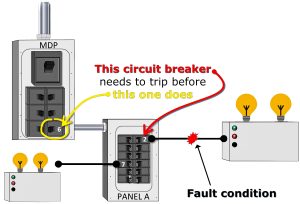How does the 2023 NEC change selective coordination requirements?
 Overview
Overview
Overcurrent protective devices are required by the NEC to provide a layer of protection for equipment and personnel. Ideally, these overcurrent protective devices will isolate only the portion of the circuit that has cause for disconnection due to a short-circuit, or ground-fault event. In reality, however, short-circuit and/or ground-faults have the capacity to trip up-stream protective devices. This up-stream propagation of faults can cause larger problems. For example, if a ground fault occurs on a 20-ampere branch circuit feeding a bathroom in an elder-care facility, it would be a problem if the main service breaker trips instead of the local GFCI. This possibility is mitigated with selective coordination. The 2023 NEC has added clarification in new Section 240.11 regarding the requirements for systems requiring selective coordination.
Applying the 2023 Code
Previous editions of the NEC, one could interpret that only certain feeders requiring selective coordination needed to be included in the coordination study. The 2023 NEC has added Section 240.11 which clarifies that if any feeder overcurrent protective devices in a given electrical system require selective coordination, then all of the feeders must be selectively coordinated with the service overcurrent device. This holds true even if a particular feeder branch does not have any loads that are required to be selectively coordinated. This change will ensure that the service overcurrent protective device has a much smaller chance of tripping when not necessary. Moving forward, the electrical professional must ensure that all feeder overcurrent devices connected to a service requiring selective coordination are properly coordinated.
What’s New for the 2023 NEC?
2020 NEC
In the 2020 NEC Section 240.11 did not exist
2023 NEC
In the 2023 NEC Section 240.11 now reads as follows:
240.11 Selective Coordination.
If one or more feeder overcurrent protective devices are required to be selectively coordinated with a service overcurrent protective device by other requirements in this Code, all feeder overcurrent protective devices supplied directly by the service overcurrent protective device shall be selectively coordinated with the service overcurrent protective device.
